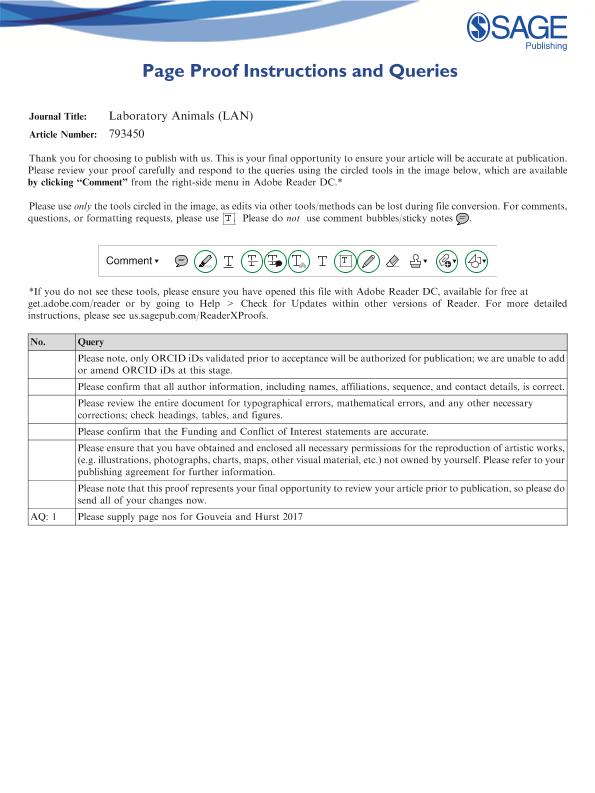Mostrar el registro sencillo del ítem
dc.contributor.author
Resasco, Agustina

dc.contributor.author
Carranza Martin, Ana Cristina

dc.contributor.author
Ayala, Miguel Angel

dc.contributor.author
Diaz, Silvina Laura

dc.contributor.author
Carbone, Cecilia
dc.date.available
2020-01-13T22:21:22Z
dc.date.issued
2018-08
dc.identifier.citation
Resasco, Agustina; Carranza Martin, Ana Cristina; Ayala, Miguel Angel; Diaz, Silvina Laura; Carbone, Cecilia; Non-aversive photographic measurement method for subcutaneous tumours in nude mice; Royal Soc Medicine Press Ltd; Laboratory Animals; 53; 4; 8-2018; 352-361
dc.identifier.issn
0023-6772
dc.identifier.uri
http://hdl.handle.net/11336/94592
dc.description.abstract
We have developed a new method for the measurement of subcutaneous tumour volume which consists in taking photographs of mice in their home cages, to refine the standard method of measurement with calipers. We consider this new method to be non-aversive, as it may be more compatible with mice behavioural preferences and, therefore, improve their welfare. Photographs are captured when mice voluntarily go into an acrylic tube containing graph paper that is later used as a scale. Tumour volumes measured with the caliper and the non-aversive photographic method were compared to those obtained by water displacement volume and weight. Behavioural and physiological changes were evaluated to assess animal welfare. Significant differences were found between measurements obtained with the caliper and the non-aversive photographic method, v. the reference volume acquired by water displacement (P < 0.001). Nevertheless, there was good consistency for these measurements when tumours were measured repeatedly, with all Intra-Class Correlation Coefficients above 0.95. Mice on which the non-aversive photographic method was employed were significantly less reluctant to establish contact with the experimenter (P < 0.001) and behaved less anxiously in a modified-Novelty Suppressed Feeding test. Particularly, statistically significant differences were found in connection with the latency to eat an almond piece (P < 0.05), the frequency of grooming (P < 0.001) and the frequency of defecation (P < 0.001). Corticosterone concentration in faeces and blood glucose were determined and no significant changes were found. Therefore, we propose the non-aversive photographic method to measure subcutaneous tumours as a way to refine methodologies in the field of experimental oncology.
dc.format
application/pdf
dc.language.iso
eng
dc.publisher
Royal Soc Medicine Press Ltd

dc.rights
info:eu-repo/semantics/openAccess
dc.rights.uri
https://creativecommons.org/licenses/by-nc-sa/2.5/ar/
dc.subject
TUMORS
dc.subject
PHOTOGRAPHIC
dc.subject
NUDE
dc.subject
MICE
dc.subject
NON-AVERSIVE
dc.subject
REFINEMENT
dc.subject
TUMOUR MODEL
dc.subject
WELFARE
dc.subject.classification
Otras Ciencias Veterinarias

dc.subject.classification
Ciencias Veterinarias

dc.subject.classification
CIENCIAS AGRÍCOLAS

dc.title
Non-aversive photographic measurement method for subcutaneous tumours in nude mice
dc.type
info:eu-repo/semantics/article
dc.type
info:ar-repo/semantics/artículo
dc.type
info:eu-repo/semantics/publishedVersion
dc.date.updated
2019-10-17T15:46:20Z
dc.journal.volume
53
dc.journal.number
4
dc.journal.pagination
352-361
dc.journal.pais
Reino Unido

dc.journal.ciudad
Londres
dc.description.fil
Fil: Resasco, Agustina. Universidad Nacional de La Plata. Facultad de Ciencias Veterinarias. Laboratorio de Animales de Experimentación; Argentina
dc.description.fil
Fil: Carranza Martin, Ana Cristina. Universidad Nacional de La Plata. Facultad de Ciencias Veterinarias. Laboratorio de Animales de Experimentación; Argentina. Consejo Nacional de Investigaciones Científicas y Técnicas. Centro Científico Tecnológico CONICET- La Plata. Instituto de Genética Veterinaria "Ing. Fernando Noel Dulout". Universidad Nacional de La Plata. Facultad de Ciencias Veterinarias. Instituto de Genética Veterinaria; Argentina
dc.description.fil
Fil: Ayala, Miguel Angel. Universidad Nacional de La Plata. Facultad de Ciencias Veterinarias. Laboratorio de Animales de Experimentación; Argentina
dc.description.fil
Fil: Diaz, Silvina Laura. Consejo Nacional de Investigaciones Científicas y Técnicas. Oficina de Coordinación Administrativa Houssay. Instituto de Biología Celular y Neurociencia "Prof. Eduardo de Robertis". Universidad de Buenos Aires. Facultad de Medicina. Instituto de Biología Celular y Neurociencia; Argentina
dc.description.fil
Fil: Carbone, Cecilia. Universidad Nacional de La Plata. Facultad de Ciencias Veterinarias. Laboratorio de Animales de Experimentación; Argentina
dc.journal.title
Laboratory Animals

dc.relation.alternativeid
info:eu-repo/semantics/altIdentifier/url/http://journals.sagepub.com/doi/10.1177/0023677218793450
dc.relation.alternativeid
info:eu-repo/semantics/altIdentifier/doi/http://dx.doi.org/10.1177/0023677218793450
Archivos asociados
